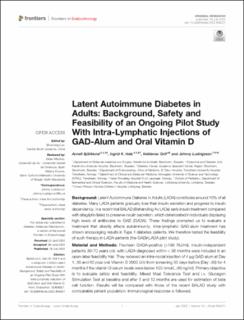| dc.contributor.author | Björklund, Anneli | |
| dc.contributor.author | Hals, Ingrid Kathrin | |
| dc.contributor.author | Grill, Valdemar Erik Robert | |
| dc.contributor.author | Ludvigsson, Johnny | |
| dc.date.accessioned | 2023-01-31T15:45:39Z | |
| dc.date.available | 2023-01-31T15:45:39Z | |
| dc.date.created | 2022-11-09T08:08:46Z | |
| dc.date.issued | 2022 | |
| dc.identifier.citation | Frontiers in Endocrinology. 2022, 13 . | en_US |
| dc.identifier.issn | 1664-2392 | |
| dc.identifier.uri | https://hdl.handle.net/11250/3047503 | |
| dc.description.abstract | Background: Latent Autoimmune Diabetes in Adults (LADA) constitutes around 10% of all diabetes. Many LADA patients gradually lose their insulin secretion and progress to insulin dependency. In a recent trial BALAD (Behandling Av LADa) early insulin treatment compared with sitagliptin failed to preserve insulin secretion, which deteriorated in individuals displaying high levels of antibodies to GAD (GADA). These findings prompted us to evaluate a treatment that directly affects autoimmunity. Intra-lymphatic GAD-alum treatment has shown encouraging results in Type 1 diabetes patients. We therefore tested the feasibility of such therapy in LADA-patients (the GADinLADA pilot study).
Material and Methods: Fourteen GADA-positive (>190 RU/ml), insulin-independent patients 30-70 years old, with LADA diagnosed within < 36 months were included in an open-label feasibility trial. They received an intra-nodal injection of 4 μg GAD-alum at Day 1, 30 and 60 plus oral Vitamin D 2000 U/d from screening 30 days before (Day -30) for 4 months if the vitamin D serum levels were below 100 nmol/L (40 ng/ml). Primary objective is to evaluate safety and feasibility. Mixed Meal Tolerance Test and i.v. Glucagon Stimulation Test at baseline and after 5 and 12 months are used for estimation of beta cell function. Results will be compared with those of the recent BALAD study with comparable patient population. Immunological response is followed.
Results: Preliminary results show feasibility and safety, with almost stable beta cell function and metabolic control during follow-up so far (5 months).
Conclusions: Intra-lymphatic GAD-alum treatment is an option to preserve beta cell function in LADA-patients. An ongoing trial in 14 LADA-patients show feasibility and safety. Clinical and immunological responses will determine how to proceed with future trials. | en_US |
| dc.language.iso | eng | en_US |
| dc.publisher | Frontiers Media | en_US |
| dc.rights | Navngivelse 4.0 Internasjonal | * |
| dc.rights.uri | http://creativecommons.org/licenses/by/4.0/deed.no | * |
| dc.title | Latent Autoimmune Diabetes in Adults: Background, Safety and Feasibility of an Ongoing Pilot Study With Intra-Lymphatic Injections of GAD-Alum and Oral Vitamin D | en_US |
| dc.title.alternative | Latent Autoimmune Diabetes in Adults: Background, Safety and Feasibility of an Ongoing Pilot Study With Intra-Lymphatic Injections of GAD-Alum and Oral Vitamin D | en_US |
| dc.type | Peer reviewed | en_US |
| dc.type | Journal article | en_US |
| dc.description.version | publishedVersion | en_US |
| dc.source.pagenumber | 11 | en_US |
| dc.source.volume | 13 | en_US |
| dc.source.journal | Frontiers in Endocrinology | en_US |
| dc.identifier.doi | 10.3389/fendo.2022.926021 | |
| dc.identifier.cristin | 2070928 | |
| cristin.ispublished | true | |
| cristin.fulltext | original | |
| cristin.qualitycode | 1 | |

